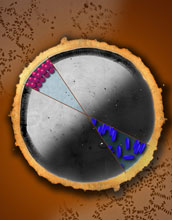Multimedia Gallery
The shape of particles in a drop of liquid plays a role in the "coffee ring effect."
This illustration represents a how a dried drop would appear if it contained round particles (red) or elongated particles (blue).
When a drop of coffee or tea dries, its particles (which are round) leave behind a ring-like stain called the "coffee ring effect" (upper left). But if you change the shape of the particles, the coffee stain behavior changes too. Elongated particles (blue) do not exhibit the coffee ring effect, rather they are deposited across the entire area of the drop, resulting in a uniformly dark stain (lower right).
Credit: Felice Macera, University of Pennsylvania
Images credited to the National Science Foundation, a federal agency, are in the public domain. The images were created by employees of the United States Government as part of their official duties or prepared by contractors as "works for hire" for NSF. You may freely use NSF-credited images and, at your discretion, credit NSF with a "Courtesy: National Science Foundation" notation.
Additional information about general usage can be found in Conditions.
Also Available:
Download the high-resolution JPG version of the image. (4.5 MB)
Use your mouse to right-click (Mac users may need to Ctrl-click) the link above and choose the option that will save the file or target to your computer.
Related story: The Future of Inks, Paints and Coatings Takes Shape



